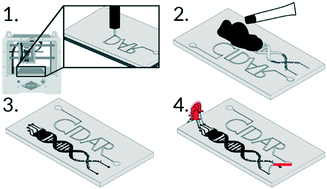Rapid and inexpensive microfluidic electrode integration with conductive ink†
Abstract
Electrode integration significantly increases the versatility of droplet microfluidics, enabling label-free sensing and manipulation at a single-droplet (single-cell) resolution. However, common fabrication techniques for integrating electronics into microfluidics are expensive, time-consuming, and can require cleanroom facilities. Here, we present a simple and cost-effective method for integrating electrodes into thermoplastic microfluidic chips using an off-the-shelf conductive ink. The developed conductive ink electrodes cost less than $10 for an entire chip, have been shown here in channel geometries as small as 75 μm by 50 μm, and can go from fabrication to testing within a day without a cleanroom. The geometric fabrication limits of this technique were explored over time, and proof-of-concept microfluidic devices for capacitance sensing, droplet merging, and droplet sorting were developed. This novel method complements existing rapid prototyping systems for microfluidics such as micromilling, laser cutting, and 3D printing, enabling their wider use and application.



 Please wait while we load your content...
Please wait while we load your content...